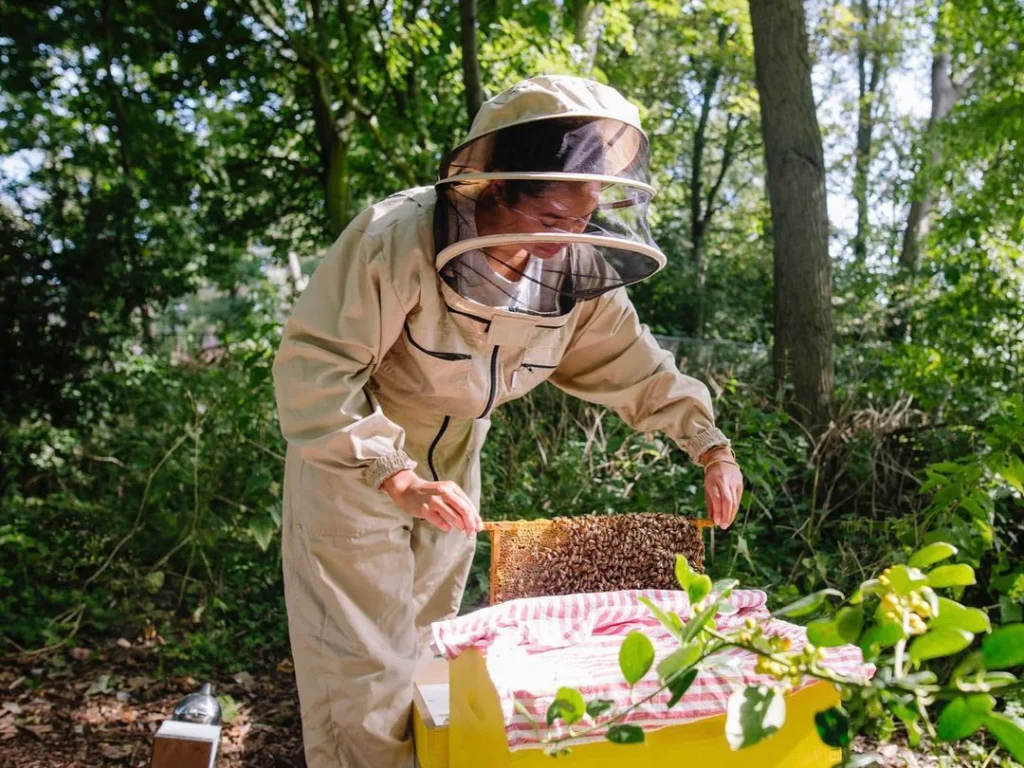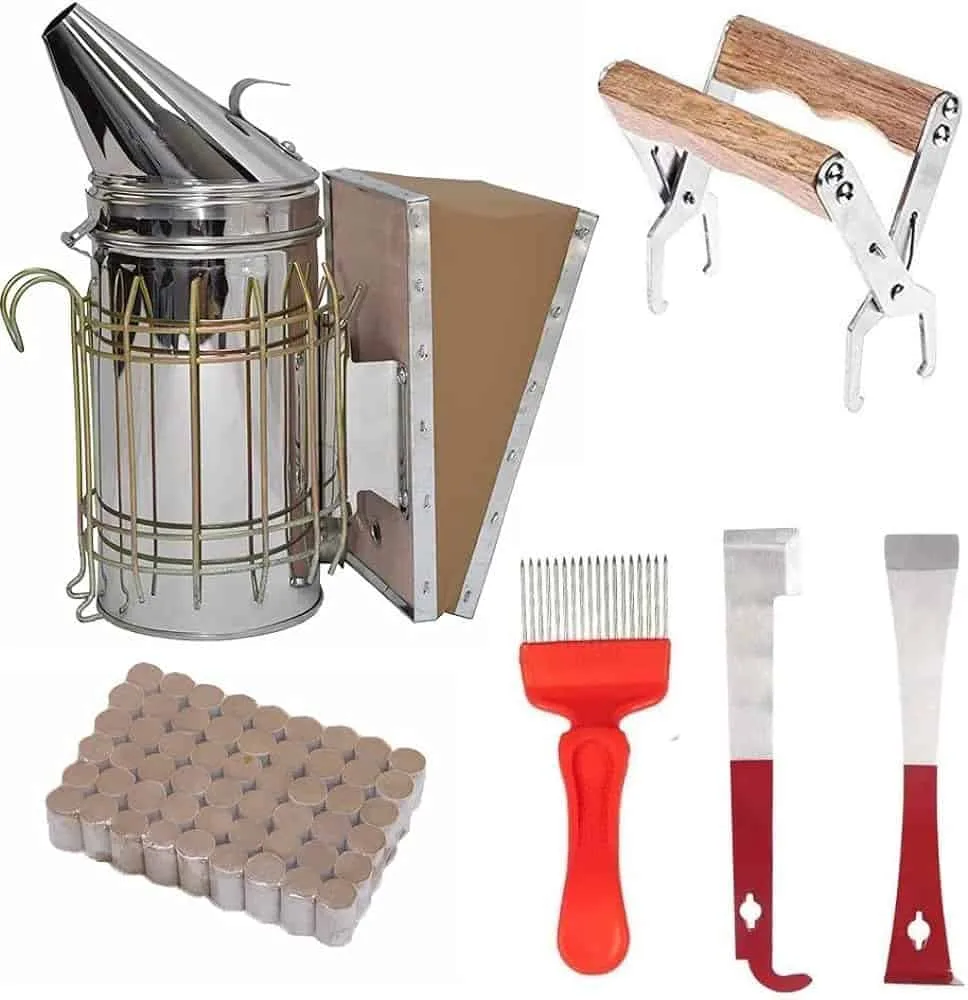So, you’ve decided to pick up beekeeping? Congratulations! 🥳 You’re about to join the ranks of the many bee enthusiasts who are contributing to our ecosystem’s sustainability. But before you dive into this honey-sweet venture, you’ll need the best beekeeping starter kit to get off to a flying start.
Urban beekeeping is on the rise, with over 60% of large cities worldwide now having initiatives or regulations to support rooftop and community garden beekeeping. Cities like New York, London, and Paris are leading the charge.
With an overwhelming number of options out there, choosing the right beekeeping kit can feel a bit like finding a needle in a haystack. Worry not! I’ve got your back.
Let’s walk through this beekeeping guide, everything you need with plenty of laughs, relatable anecdotes, and a sprinkle of wisdom.
Table Of Contents
- 1 Why Start Beekeeping?
- 2 Essential Components of a Beekeeping Starter Kit
- 3 5 Best Beekeeping Starter Kit for Beginners:
- 4 How to Set Up Your Beekeeping Kit?
- 5 Understanding Bee Behavior
- 6 Common Beekeeping Challenges
- 7 Beekeeping Throughout the Seasons
- 8 Harvesting Your Honey
- 9 How To Protect Your Bees?
- 10 Beekeeping Communities
- 11 Conclusion
Why Start Beekeeping?

In 2024, the global beekeeping market is estimated to be valued at around $10.4 billion.
Okay, let’s cut to the chase. Why beekeeping, you ask? Well, not only does it make you look like a backyard hero, but it also provides numerous benefits:
- Eco-friendly: Bees are vital for pollination, which supports plant growth, including many of the foods we eat daily.
- Fresh Honey: Talk about organic! You’ll have the freshest honey around.
- Therapeutic Hobby: Tending to bees can be incredibly calming.
- Education: Beekeeping is educational for both children and adults.
I started beekeeping after my wife threatened to turn our backyard into a garden paradise, and guess who had to step in and help with pollination? Yep, yours truly. A few bee stings later, I’ve never been more invested!
Essential Components of a Beekeeping Starter Kit
To get your beekeeping journey off to a stellar start, you’ll need a kit with the right components. Here’s a breakdown:
a. Bee Hive Kits

First thing’s first, you need a place for your bees to call home. Bee hive kits usually come in different types like:
- Langstroth Hive: The most common and beginner-friendly.
- Top Bar Hive: Simple design and more natural methods.
- Warre Hive: Mimics a bee’s natural habitat.
When I first started, I opted for the Langstroth Hive. It’s like the Cadillac of bee hives. Sure, my first build looked like a Picasso painting, but it worked!
b. Beekeeper Suit and Gloves

Safety first, people! Bees can be a little ticked off if disturbed. Invest in a high-quality beekeeper suit and gloves. You don’t want your first beekeeping experience to involve sprinting across your backyard, flailing your arms like a mad person.
c. Smoker

The smoker is a game changer. It calms bees and reduces the likelihood of them attacking. Plus, you get to look like you’re about to perform a magic trick. Double win!
d. Hive Tool

It’s the Swiss Army knife for beekeepers. The hive tool helps you lift frames, scrape off wax, and separate boxes. Trust me, you’ll feel like a pro with this.
e. Bee Brush

This soft-bristled brush removes bees from the frames without harming them. It’s a gentle nudge to let them know you need to borrow their frames for a second.
5 Best Beekeeping Starter Kit for Beginners:
Alright, let’s get into the nitty-gritty of selecting your startup kit. Here are some best beekeeping startup kits to consider:
1. BeeCastle Beekeeping Supplies Beekeeping Tools

The BeeCastle Beekeeping Supplies Kit is a comprehensive set designed to provide essential tools for both novice and experienced beekeepers. This 9-piece kit aims to equip users with the necessary tools to manage and maintain a beehive effectively.
Included Tools:
- Bee Smoker: A crucial tool for calming bees when managing the hive.
- Hive Grip: Used to handle and inspect frames with ease.
- Bee Brush: Soft-bristled brush for gently removing bees from the frames.
- Uncapping Fork: Used for removing the wax cappings from honeycombs in honey extraction.
- Z Tool: Multi-functional hive tool for prying apart hive bodies and frames.
- Queen Cage: Used to protect and transport the queen bee.
- Bee Feeder: Device for supplying food to the bees.
- Frame Cleaner: Allows for the removal of debris and propolis from the frames.
- Frame Grip: Assists in the safe removal and handling of frames from the hive.
Pros:
- Full Startup Kit: Contains essential tools required for basic hive management and maintenance.
- Quality and Durability: The tools are built to last, providing reliability to the user.
- Beginner Friendly: Ideal for those who are new to beekeeping, with tools designed to simplify hive management.
Cons:
- Limited Advanced Tools: May not fully meet the needs of advanced beekeepers looking for specialized equipment.
- Manual Language: If the manual is only in English, it could pose a challenge for non-English speakers.
- Additional Equipment: May require supplementary purchases for a fully comprehensive beekeeping setup (e.g., extra protective gear or hive boxes).
2. Blisstime Beekeeping Supplies, 30 PCS Bee Keeping Starter Kit

with a wide range of tools necessary for efficient hive management and honey production, this 30-piece kit includes a variety of tools that are essential for different aspects of beekeeping.
Included Tools:
- Honey Uncapping Fork: Essential for removing wax cappings from honeycombs.
- Queen Bee Catcher: Tool used to safely capture and transport the queen bee.
- Honeycomb Reinforcement Tools: Used to support and maintain the structure of honeycombs.
- Honey Harvesting Tools: Includes various items such as a bee brush and hive tool for efficient honey extraction.
- Beehive Maintenance Tools: Instruments such as frame grips, a hive tool, and a smoker to assist in regular hive checks and maintenance.
- Bee Feeder: To provide supplemental feed to the bees.
- Protective Gear: Basic protection items like gloves and a veil are included for the beekeeper’s safety.
Pros:
- All in one and Versatile: The extensive range of tools caters to various beekeeping needs, making it a versatile kit for new and experienced beekeepers alike.
- Cost-Effective: Provides a large number of tools in one package, often more economical compared to buying tools separately.
- Beginner Friendly: Designed with the beginner in mind, it includes most tools needed to start and maintain a beehive efficiently.
Cons:
- Tool Quality Variation: Some users may find the quality of certain tools to be less durable compared to specialist brands.
- Manual Language and Details: If the manual is not comprehensive or available in multiple languages, it may hinder non-English speaking users.
- Additional Purchases: Users might need to buy extra equipment such as more advanced protection gear or additional hive boxes depending on their specific needs.
3. Honey Lake Bee Starter Kit

This kit includes a bee smoker with 54 bee smoker pellets, along with additional essential tools like a frame holder grip and an uncapping fork, making it suitable for both beginner and experienced beekeepers. Here’s a detailed look at the components and features of this kit:
Included Tools:
- Bee Smoker: Used for calming bees, making hive inspections and honey harvesting less stressful.
- 54 Bee Smoker Pellets: These pellets provide sustained smoke to keep bees calm for an extended period.
- Frame Holder Grip: Assists in lifting and inspecting hive frames easily.
- Uncapping Fork: Utilized to uncap honeycombs during honey extraction.
- 2 Bee Hive Tools: Essential for prying apart hive bodies, scraping off excess propolis, and other maintenance tasks.
Pros:
- Best Smoking and Maintenance Kit: Provides all necessary tools for smoke-based hive management and routine hive maintenance.
- High-Quality Smoker Pellets: The 54 pellets are formulated to burn steadily and produce consistent smoke, crucial for beekeeper safety and ease.
- User-Friendly: The design of the tools makes them accessible for beginners and useful for experienced beekeepers.
Cons:
- Limited Protective Gear: This kit focuses mainly on tools and does not include protective clothing like gloves or a veil, which will need to be purchased separately.
- Manual Language: If the user manual is not available in multiple languages, it may be less accessible to non-English speakers.
- Specialized Use: While excellent for smoking and basic frame inspection, additional beekeeping tasks may require more specialized tools or additional kits.
Although the kit focuses on tools rather than protective gear, it serves as a valuable addition to any beekeeper’s arsenal, providing key equipment needed for effective and safer hive interactions.
4. Beehive Starter Kit 10-Frame Bee Boxes and Frames Starter Kit

The Beehive Starter Kit with 10-Frame Bee Boxes and Frames is designed to offer new and established beekeepers a quick ways for setting up and maintaining a functional bee colony. The beekeeping startup kit comes with wax-coated bee hives and necessary tools, including a beekeeping veil for added safety.
Included Tools and Components:
- 10-Frame Bee Boxes and Frames: Provides the structural foundation for the beehive, allowing bees to build their colony.
- Wax-Coated Bee Hives: Frames coated with beeswax to encourage bees to build their combs precisely and more quickly.
- Beekeeping Veil: Essential protective gear to keep the beekeeper safe from bee stings while inspecting the hive.
- Beekeeping Tools Kit: Includes various essential tools such as:
- Hive tool for prying apart hive bodies and frames.
- Bee brush for gently removing bees from the frames during inspection.
- Frame holder grip for lifting frames out of the hive.
- Uncapping fork for honey extraction.
5. Bee Smoker: Used to calm bees during hive inspections, making the process smoother and safer.
Pros:
- All-In-One Solution: Provides a variety of tools and components that cover the essential needs for starting beekeeping.
- Quality and Durability: The wax-coated frames and sturdy tools ensure long-term use and reliability.
- Safety: Inclusion of a beekeeping veil enhances safety for the beekeeper during hive inspections.
Cons:
- Sometimes Additional Equipment Needed: While simple setup solution, users may need to purchase additional protective gear or specialized tools for more advanced beekeeping activities.
- Manual Language and Instructions: Limited language options in the manual could pose difficulties for non-English speakers.
- Initial Setup: Beginners might require some guidance or additional resources to fully understand and set up the beehive effectively. Needed some guidance.
The Beehive Starter Kit with 10-Frame Bee Boxes and Frames is an extensive and practical solution designed to meet the needs of new and seasoned beekeepers.
Best for those who want to hit the ground running and have the budget to invest in some premium quality.
5. Mann Lake HK110 Basic Beekeeping Starter Kit

The Mann Lake HK110 Basic Beekeeping Starter Kit is designed to provide beginners with everything they need to start their beekeeping journey. This kit includes assembled and painted components, making it ready for immediate use. The kit focuses on providing quality and simplicity, ensuring that even those new to beekeeping can manage their hives effectively.
Included Components and Tools:
- 10-Frame Bee Box: The main structure of the hive, which houses the frames where bees build their combs.
- Pre-Assembled and Painted: The hive components come fully assembled and painted, saving time and effort for the user.
- Frames: Included frames that fit into the bee box, allowing for easy management and inspection of the hive.
- Inner Cover and Telescoping Top Cover: Protects the hive from the elements and provides bees with a stable environment.
- Bottom Board: The base of the hive, which supports the entire structure.
- Entrance Reducer: Helps control bee traffic and ventilation through the hive entrance.
- Foundation Sheets: Used within the frames to support the construction of the honeycomb.
Pros:
- Ease of Use: The fully assembled and painted components reduce setup time and complexity, making it beginner-friendly.
- Durable Construction: High-quality materials and construction ensure the hive components are durable and long-lasting.
- Complete Kit: Provides virtually all essential items needed for starting beekeeping, simplifying the purchasing process.
Cons:
- May Require Additional Tools: While comprehensive, the kit may still require additional tools and protective gear for complete hive management.
- Higher Initial Cost: Being fully assembled and painted, the kit may be more expensive compared to DIY options.
- Manual Language and Details: The included instructions, if in limited languages, could pose difficulties for non-English speakers.
The pre-assembled and painted hive parts save beginners time and effort, allowing them to focus on the essentials of hive management.
How to Set Up Your Beekeeping Kit?
New beekeeping operations have seen an annual growth rate of approximately 8%.
a. Choose the Right Location
Find a sunny spot in your backyard that’s shielded from strong winds. The neighbors might not appreciate their morning coffee interrupted by a surprise bee swarm.
b. Assembling the Hive
Follow the kit instructions religiously. Every piece has its place. Screwing in the wrong part is like putting on your pants after your shoes. Counterproductive and awkward.
c. Installing Your Bees
Order your bees from a reputable supplier. When they arrive, carefully introduce them to their new home. It’s like setting up a surprise housewarming party – only with a buzzing guest list.
d. Regular Maintenance
Beekeeping isn’t a set-it-and-forget-it hobby. Regular hive inspections for pests or diseases are vital. It’s akin to checking on a highly intricate and dynamic family you can’t verbally communicate with.
Understanding Bee Behavior
1. The Queen Bee
The queen is the heart of the colony. She lays all the eggs and, much like a real queen, commands the hive’s attention and respect. Think of her as Beyonce, but with wings.
2. Worker Bees
These ladies are the warriors, the nurturers, the builders, and the grocery shoppers of the hive. All female, they’re responsible for nearly everything, from cleaning to foraging.
3. Drones
These are the male bees whose sole purpose is to mate with the queen. Post mating, they die. Talk about having a single focus in life.
Common Beekeeping Challenges

While beekeeping can be a rewarding and fulfilling hobby or profession, it’s not without its challenges. From pests and diseases to environmental issues, beekeepers must navigate a variety of obstacles to maintain healthy hives.
1. Varroa Mite Infestations
Despite increased awareness, 30% of beekeepers report moderate to high losses in bee colonies annually, primarily due to pesticide exposure.
These tiny vampires can cripple your colony. Regular chemical treatments and monitoring are crucial to avoid losing your hive.
2. Colony Collapse Disorder (CCD)
This mysterious phenomenon causes bees to abandon their hives. Keeping your bees healthy and stress-free can help in prevention.
3. Swarming
Swarming happens when the bees feel overcrowded. Regular hive inspections and adding extra space can mitigate this.
4. Wax Moths
Wax moths are pests that damage hives by laying eggs that hatch into larvae, which then consume and tunnel through honeycombs.
5. Weather and Environmental Challenges
Proper weather and sudden environmental changes can affect their living and can destroy the whole colony. So you need to get updated on these regularly.
Beekeeping Throughout the Seasons
Beekeeping is a year-round commitment that demands attention to seasonal changes and the bees’ needs during those times. By following these seasonal guidelines, you can ensure a healthy, thriving hive and a bountiful honey harvest.
a. Spring: The Awakening
Hello, bee activity! The colony ramps up production. Ensure ample food supply and start hive inspections.
b. Summer: The Peak
Peak season! The bees are at full throttle, and honey production is high. Keep an eye out for any potential problems.
c. Fall: The Preparation
Prepare for winter by feeding your bees sugar syrup. Inspect the hive and ensure no diseases or pests.
d. Winter: The Hibernate
Wrap up your hive to keep it warm. Regularly check but avoid opening the hive during freezing temperatures.
Harvesting Your Honey
World honey production is projected to reach approximately 2 million metric tons in 2024.
This is the moment you’ve been waiting for. Here’s how to get it done without causing a commotion:
- Use the smoker to calm the bees.
- Remove the frames with capped honey.
- Uncap the honey using a hot knife.
- Extract the honey using a centrifugal extractor.
- Filter to remove any impurities.
- Bottle your honey and enjoy the fruits of your labor!
Remember my first harvest? I felt like Winnie the Pooh, minus the repetitive outfit. The taste of that first spoonful of honey? Pure nectar of the gods!
How To Protect Your Bees?
Ensure your bees are happy and healthy by, here are 10 simple ways to protect your bee colony.
- Choose a sunny spot shielded from wind with easy access to water and away from high-traffic areas.
- Inspect every 7-10 days during peak seasons and monitor for pests, diseases, and proper queen activity.
- Use sugar syrup (1:1 water to sugar in spring/summer, 2:1 in winter) and pollen patties during forage shortages.
- Perform regular inspections using sugar shake or alcohol wash and treat with miticides or natural remedies.
- Implement traps, ground treatments, maintain strong hives, and freeze frames to prevent infestations.
- Install bee guards, use electric fencing in bear-prone areas, and elevate stands to deter skunks and raccoons.
- Burn hives infected with American Foulbrood, use antibiotics for lesser infections, and treat Nosema with Fumagillin.
- Avoid pesticide use near hives, plant bee-friendly flowers, winterize hives for cold, and provide shade and ventilation in summer.
- Clean and disinfect tools and equipment regularly with soap, water, and bleach solutions.
- Join beekeeping communities, participate in forums and local clubs, and continue learning through workshops and up-to-date literature.
Beekeeping Communities
Join local beekeeping clubs or online forums. Community support can be a treasure trove of advice and a great place to share your triumphs and tribulations.
Here are some of the most famous beekeeping communities—both online and in-person:
- BeekeepingForums.com
- BeeSource.com
- American Beekeeping Federation (ABF)
- British Beekeepers Association (BBKA)
- Apimondia
- Facebook Groups
- Beekeepers of the World
- California State Beekeepers Association (CSBA)
- Sydney Bee Club
- Reddit – r/Beekeeping
- Instagram Hashtags – #beekeeping, #beekeepers and #urbanbeekeeping
- The Bush Bee Man YouTube Channel
Conclusion
Starting your beekeeping journey can be both exhilarating and nerve-wracking. With the right beekeeping starter kit, a sprinkle of patience, and a sense of humor, you’ll be well on your way to becoming a successful beekeeper. Remember, the key is learning and growing along with your bees. Here’s to a buzzing adventure and jars of golden honey!
Now go on, be the bee whisperer you were destined to be, and let your backyard buzz with the symphony of nature! 🐝✨






















